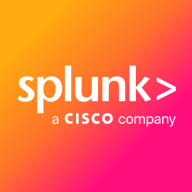

Splunk Enterprise Security and Grafana Loki are key players in the log management and analysis space. Splunk has an advantage, particularly for large enterprises, with its extensive features and real-time threat detection capabilities, while Grafana Loki is appealing for its simplicity and cost-effectiveness, especially for budget-conscious organizations and non-technical users.
Features: Splunk Enterprise Security offers end-to-end visibility, advanced threat management, and robust data ingestion capabilities. It utilizes schema-on-read technology and a versatile Search Processing Language (SPL) for sophisticated data manipulation, supporting integration across multi-cloud environments. Grafana Loki focuses on providing simple, cost-effective log management through seamless integrations with open-source tools like Prometheus. Its user-friendly dashboards are easy to create and cater to organizations looking for straightforward, open-source solutions.
Room for Improvement: Splunk could refine its operational workflows, enhance integration with various systems, and improve its user interface and documentation to assist usability. Grafana Loki could enhance its dashboard customization, alert functionalities, and stability, particularly within complex environments. Both tools would benefit from improved user experience and more comprehensive documentation.
Ease of Deployment and Customer Service: Splunk offers a variety of deployment options but requires technical expertise, and its customer service experiences can vary. In contrast, Grafana Loki’s open-source nature allows easy deployment and cost-effective scalability, relying on community-driven support, which may lack the depth of Splunk's formal services.
Pricing and ROI: Splunk's pricing is high, based on data ingestion volumes, but its comprehensive features promise significant ROI for large enterprises. Grafana Loki’s open-source model provides a more affordable, budget-friendly structure that appeals to organizations seeking efficient log management without high costs.
| Product | Market Share (%) |
|---|---|
| Splunk Enterprise Security | 7.7% |
| Grafana Loki | 7.9% |
| Other | 84.4% |


| Company Size | Count |
|---|---|
| Small Business | 7 |
| Midsize Enterprise | 8 |
| Large Enterprise | 3 |
| Company Size | Count |
|---|---|
| Small Business | 110 |
| Midsize Enterprise | 50 |
| Large Enterprise | 257 |
Grafana Loki is a powerful log aggregation and analysis tool designed for cloud-native environments. Its primary use case is to collect, store, and search logs efficiently, enabling organizations to gain valuable insights from their log data.
The most valuable functionality of Loki is its ability to scale horizontally, making it suitable for high-volume log data. It achieves this by utilizing a unique indexing approach called "Promtail," which efficiently indexes logs and allows for fast searching and filtering. Loki also supports log streaming in real-time, ensuring that organizations can monitor and analyze logs as they are generated.
By centralizing logs in a single location, Loki simplifies log management and troubleshooting processes. It provides a unified view of logs from various sources, making it easier to identify and resolve issues quickly. With its powerful query language, organizations can extract meaningful information from logs, enabling them to gain insights into system performance, identify anomalies, and detect potential security threats.
Loki's integration with Grafana, a popular open-source visualization tool, allows users to create rich dashboards and visualizations based on log data. This combination enhances the observability of systems and applications, enabling organizations to make data-driven decisions and improve overall operational efficiency.
Splunk Enterprise Security delivers powerful log management, rapid searches, and intuitive dashboards, enhancing real-time analytics and security measures. Its advanced machine learning and wide system compatibility streamline threat detection and incident response across diverse IT environments.
Splunk Enterprise Security stands out in security operations with robust features like comprehensive threat intelligence and seamless data integration. Its real-time analytics and customizable queries enable proactive threat analysis and efficient incident response. Integration with multiple third-party feeds allows detailed threat correlation and streamlined data visualization. Users find the intuitive UI and broad compatibility support efficient threat detection while reducing false positives. Despite its strengths, areas such as visualization capabilities and integration processes with cloud environments need enhancement. Users face a high learning curve, and improvements in automation, AI, documentation, and training are desired to maximize its potential.
What Are the Key Features of Splunk Enterprise Security?In specific industries like finance and healthcare, Splunk Enterprise Security is instrumental for log aggregation, SIEM functionalities, and compliance monitoring. Companies leverage its capabilities for proactive threat analysis and response, ensuring comprehensive security monitoring and integration with various tools for heightened operational intelligence.
We monitor all Log Management reviews to prevent fraudulent reviews and keep review quality high. We do not post reviews by company employees or direct competitors. We validate each review for authenticity via cross-reference with LinkedIn, and personal follow-up with the reviewer when necessary.